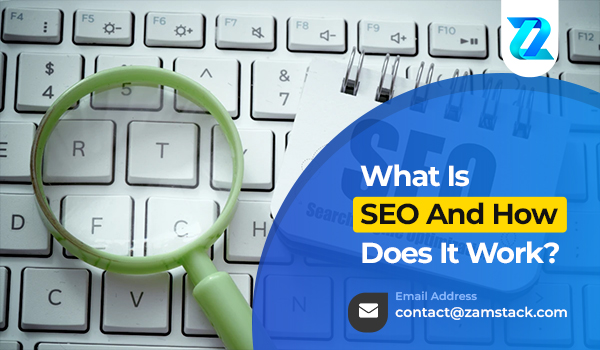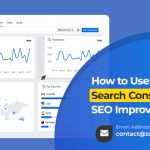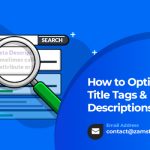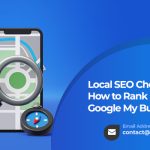In today’s digital landscape, where millions of websites are vying for attention, how does one ensure their website stands out in the crowded online space? The answer lies in SEO (Search Engine Optimization). SEO is the backbone of digital marketing, helping websites climb the search engine ranks and reach their target audience. But what exactly is SEO, and how does it work?
In this blog post, we’ll break down the fundamentals of SEO, explain why it’s so crucial for your business, and guide you through how it can help you gain more visibility, traffic, and ultimately, conversions. Whether you’re a business owner or just curious about SEO, this guide will give you the insights you need to get started.
What Does SEO Stand For?
SEO stands for Search Engine Optimization. In simple terms, it’s the process of making your website more visible to people who are searching for products, services, or information related to your business on search engines like Google, Bing, or Yahoo.
Imagine SEO as a digital map. If your website is optimized correctly, that map leads users straight to your door. If not, well… you’re just another invisible dot in a sea of endless content.
Why SEO Is Important in 2025
In 2025, SEO is more crucial than ever. With over 5 billion searches per day on Google alone, showing up on the first page can make or break your business. The way people search has evolved—voice search, AI, and mobile usage have completely reshaped the game. Without SEO, you’re simply handing your competitors the spotlight.
The Core Purpose of SEO
Driving Organic Traffic
The primary goal of SEO? Attract free, consistent traffic to your website. Unlike paid ads, SEO doesn’t charge you per click. Instead, it brings in visitors naturally—people who are already searching for what you offer.
Building Authority & Trust
Ranking high in search results sends a signal: “Hey, this site knows what it’s talking about!” Over time, effective SEO builds credibility, authority, and trust—both in the eyes of users and search engines.
How Search Engines Work
Crawling, Indexing, and Ranking Explained
Let’s break it down:
-
Crawling: Search engines send out bots (called crawlers) to scan websites and gather data.
-
Indexing: After crawling, they store and organize that data.
-
Ranking: When someone types a query, the engine uses algorithms to rank the most relevant and trustworthy content.
The Role of Algorithms
Search engines like Google use hundreds of ranking factors, from content quality and user experience to backlinks and site speed. These algorithms evolve constantly—think of them as secret recipes that keep getting updated.
Key Components of SEO
On-Page SEO
This is all about what you can control on your own site.
Keywords
Using the right keywords—those phrases people type into Google—is the backbone of SEO. But don’t stuff them! Think natural, helpful, and relevant.
Meta Tags
Your meta title and meta description show up in search results. They should be compelling, accurate, and include your target keywords.
Content Quality
Content is king. And not just any content, but useful, well-written, and engaging material that answers the searcher’s intent.
Off-Page SEO
This is what happens off your website—think reputation building.
Backlinks
When other sites link to yours, it’s like a vote of confidence. The more high-quality backlinks you have, the more authority your site gains.
Social Signals
While not a direct ranking factor, shares, likes, and mentions on social media platforms can boost visibility and traffic.
Technical SEO
It’s the behind-the-scenes stuff that makes your site search engine-friendly.
Site Speed
Fast-loading sites keep users happy—and Google too.
Mobile-Friendliness
Over 60% of searches happen on mobile. If your site doesn’t look good on a phone, you’re missing out.
Structured Data
Also known as schema markup, this helps search engines understand your content better and can earn you rich snippets (like star ratings or FAQs) in search results.
Local SEO
Perfect for businesses serving a local area.
Google Business Profile
Having a fully optimized Google Business Profile helps you appear in the “Map Pack” and local search queries.
Local Citations & NAP Consistency
Ensure your Name, Address, and Phone Number (NAP) are consistent across all directories. Inconsistent info confuses Google—and your customers.
How SEO Works Step-by-Step
1. Keyword Research
Use tools like Google Keyword Planner or Ubersuggest to find what your audience is searching for.
2. On-Page Optimization
Tweak your pages—titles, headers, content, URLs—to target those keywords.
3. Content Creation
Write blog posts, service pages, guides—anything valuable that solves problems.
4. Link Building
Reach out for guest posts, earn links through great content, and list your site in quality directories.
5. Monitoring & Optimization
Track rankings, analyze traffic, and keep tweaking for better results.
Black Hat vs White Hat SEO
What’s the Difference?
-
White Hat SEO follows search engine rules—slow but steady wins the race.
-
Black Hat SEO breaks the rules—might get you quick wins but also penalties.
Why White Hat is the Way to Go
Long-term success depends on doing things right. Google’s smart—it will catch sneaky tactics sooner or later.
SEO Tools That Make Life Easier
Free Tools
-
Google Search Console
-
Google Analytics
-
Ubersuggest
Premium Tools
-
Ahrefs
-
SEMrush
-
Moz Pro
How Long Does SEO Take to Show Results?
Typically, it takes 3 to 6 months to see noticeable improvements. But the real magic happens over the long term. SEO is not a sprint—it’s a marathon.
Benefits of SEO for Businesses
-
Higher visibility and traffic
-
Increased brand credibility
-
Better user experience
-
Long-term ROI
-
Competitive advantage
Common SEO Mistakes to Avoid
-
Keyword stuffing
-
Ignoring mobile users
-
Buying backlinks
-
Duplicate content
-
Not tracking performance
Future of SEO in 2025 and Beyond
Expect more AI integration, voice search dominance, and smarter algorithms. SEO pros will need to adapt and stay ahead of trends, or risk falling behind.
Conclusion
SEO might seem overwhelming, but once you break it down, it’s really about understanding your audience and creating content they love, in a way that search engines can find and understand. Whether you’re just getting started or refining your strategy, mastering SEO is one of the smartest moves you can make in 2025.
FAQs
1. What is the difference between SEO and PPC?
SEO is organic (free traffic), while PPC involves paying for ads to appear in search results.
2. Is SEO free?
Yes, the traffic you get from SEO is free—but the work (or hiring an expert) does involve time and/or money.
3. Can I do SEO on my own?
Absolutely! With the right tools, knowledge, and consistency, DIY SEO is possible—especially for small websites.
4. How often should I update my SEO strategy?
At least every few months. Search engine algorithms and user behavior change—so should your SEO.
5. Do social media links help SEO?
Indirectly, yes. They can drive traffic and boost your content’s visibility, which can lead to more backlinks and better rankings.












